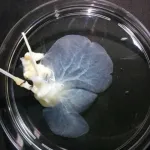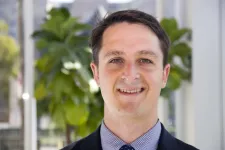(Press-News.org) Researchers at the Human Genome and Stem Cell Research Center (HUG-CELL), hosted by the University of São Paulo's Institute of Biosciences (IB-USP) in Brazil, have developed a technique to reconstruct and produce livers in the laboratory.
The proof-of-concept study was conducted with rat livers. In the next stage of their research, the scientists will adapt the technique for the production of human livers in order in future to increase the supply of these organs for transplantation.
The study was supported by FAPESP and is reported in an article published in Materials Science and Engineering: C.
"The plan is to produce human livers in the laboratory to scale. This will avoid having to wait a long time for a compatible donor and reduce the risk of rejection of the transplanted organ," Luiz Carlos de Caires-Júnior, first author of the article, told Agência FAPESP. He is a postdoctoral fellow of HUG-CELL, one of the Research, Innovation and Dissemination Centers (RIDCs) funded by FAPESP.
The methodology is based on decellularization and recellularization, tissue bioengineering techniques developed in recent years to produce organs for transplantation. An organ from a deceased donor, in this case the liver, is treated with various solutions containing detergents or enzymes to remove all the cells from the tissue, leaving only the extracellular matrix with the organ's original structure and shape. The extracellular matrix is then seeded with cells taken from the patient. The technique avoids immune system reactions and the risk of rejection in the long term.
"It's comparable to transplanting a 'reconditioned' liver. It won't be rejected because it uses the patient's own cells, and there's no need to administer immunosuppressants," said Mayana Zatz, HUG-CELL's principal investigator and last author of the article.
The technique can also be used to reconstitute organs considered borderline and non-transplantable, increasing the supply of organs for patients on the waiting list, Caires-Júnior explained.
"Many organs available for transplantation can't actually be used because the donor has died in a traffic accident. The technique can be used to repair them, depending on their status," he said.
The decellularization process, however, removes the main components of the extracellular matrix, such as molecules that tell the cells to multiply and form blood vessels, for example. This weakens cell adhesion to the extracellular matrix and compromises recellularization.
To surmount this obstacle, the HUG-CELL researchers enhanced the technique by introducing an extra stage between decellularization and recellularization.
After isolating and decellularizing rat livers, they injected into the extracellular matrix a solution rich in molecules such as SPARC and TGFB1, proteins produced by liver cells grown in a laboratory in a conditioned medium. These proteins are essential to a healthy liver as they tell liver cells to proliferate and form blood vessels.
"Enrichment of the extracellular matrix with these molecules lets it become much more similar to that of a healthy liver," Caires-Júnior said.
Rat liver extracellular matrices were treated with the solution, and hepatocytes, endothelial cells, and mesenchymal cells were introduced into the material. The mesenchymal cells were derived from human induced pluripotent stem cells (iPSCs), produced by reprogramming adult skin cells (or cells from other easily accessible tissues) into an embryonic-like pluripotent state.
"The study shows it's possible to induce human stem cell differentiation in cell lineages that are part of a liver and use these cells to reconstruct the organ so that it's functional. It's proof of concept, the first demonstration that the technique works," Zatz said.
The liver cells were injected with a syringe pump into rat liver extracellular matrices to produce an organ with human characteristics. It grew for five weeks in an incubator that simulated the conditions in the human body. Analysis showed that extracellular matrix enrichment with SPARC and TGFB1 significantly improved recellularization.
"The treatment made the liver cells grow and function more vigorously," Caires-Júnior said. "We plan to build a bioreactor to decellularize human livers and study the possibility of producing them to scale in the laboratory."
The technique can be adapted to produce other organs, such as lungs, hearts, and skin, he added.
Organ factories
The project is part of one of the research lines pursued by HUG-CELL to produce or reconstruct transplant organs using different techniques.
Through a project conducted in partnership with pharmaceutical company EMS and supported by FAPESP (São Paulo Research Foundation) under the auspices of its Research Partnership for Technological Innovation Program (PITE), the HUG-CELL researchers aim to modify pig organs such as kidneys, hearts and skin for transplantation into humans (read more at: agencia.fapesp.br/29771/).
Pig livers would be rejected if they were transplanted into humans, so the researchers are pursuing other strategies, such as 3D printing (read more at: agencia.fapesp.br/32217/), as well as decellularization and recellularization.
"These are complementary approaches. We expect to see transplant organ factories in future," Zatz said.
INFORMATION:
About São Paulo Research Foundation (FAPESP)
The São Paulo Research Foundation (FAPESP) is a public institution with the mission of supporting scientific research in all fields of knowledge by awarding scholarships, fellowships and grants to investigators linked with higher education and research institutions in the State of São Paulo, Brazil. FAPESP is aware that the very best research can only be done by working with the best researchers internationally. Therefore, it has established partnerships with funding agencies, higher education, private companies, and research organizations in other countries known for the quality of their research and has been encouraging scientists funded by its grants to further develop their international collaboration. You can learn more about FAPESP at http://www.fapesp.br/en and visit FAPESP news agency at http://www.agencia.fapesp.br/en to keep updated with the latest scientific breakthroughs FAPESP helps achieve through its many programs, awards and research centers. You may also subscribe to FAPESP news agency at http://agencia.fapesp.br/subscribe.
PITTSBURGH, April 5, 2021 - "Near-poor" Americans--people just above the federal poverty level but still well below the average U.S. income--who rely on Medicare for health insurance face high medical bills and may forgo essential health care, according to new research led by health policy scientists at the University of Pittsburgh Graduate School of Public Health. This is due to a coverage "cliff" in Medicaid, which supplements Medicare for people with incomes below poverty but excludes individuals above the federal poverty threshold, including the near-poor.
In a report published today in the April issue of the journal Health Affairs, the authors describe the effects of this cliff and propose solutions to fix it, with the aim of lessening barriers to care among near-poor people ...
PHILADELPHIA-- Approximately 6.5 million people are under correctional supervision in the United States on any given day. Justice-involved individuals (people currently or recently in prison or jail, on probation or parole, or arrested) experience higher rates of substance use disorders than the general population. In fact, among people with opioid use disorder (OUD), more than half have reported contact with the criminal justice system.
Numerous clinical studies have shown that medications for OUD -- specifically, methadone or buprenorphine -- lead to superior outcomes for retention in treatment, reduced illicit opioid use, and decreased opioid-related overdose rates and serious acute care compared with treatments that ...
PHILADELPHIA-- While the emergency department (ED) functions as an integral part of the United States healthcare safety net by handling all medical complaints regardless of insurance status, ED visits are expensive, and many are for lower-acuity conditions that may be amenable to care in other settings. Previous research has suggested that greater availability of urgent care centers - freestanding facilities with extended hours that staff emergency physicians, primary care physicians, or nurse practitioners, and focus on a broad range of lower acuity complaints, like rash, muscle strain, bronchitis, and urinary tract infection - helps decrease ED visits, but whether the centers reduce or increase net spending for patients ...
Even before the pandemic made telehealth a hot topic, people with minor urgent health needs had started to turn to companies that offer on-demand video chats with physicians that they don't normally see.
Insurers and employers even started buying access to this direct-to-consumer form of virtual care, hoping it might reduce in-person care, including emergency department visits.
But a new University of Michigan study casts some doubt on whether that will actually happen.
Published in the April issue of Health Affairs, the study finds that patients who had an on-demand ...
In a new study, researchers found nearly half of those who share explicit images of others without permission feel remorse after the fact and 24% try to deflect blame onto victims. Amy Hasinoff, a researcher at the University of Colorado Denver, joined Danish researcher Sidsel K. Harder, to take a deeper dive into the issue of sexual abuse and image sharing.
Hasinoff and Harder looked at how people who shared explicit images online spoke to police officers about the harmful acts they committed. While looking over cases where the image-sharer was caught and convicted, ...
People with ovarian cancer frequently receive aggressive end-of-life care despite industry guidelines that emphasize quality of life for those with advanced disease, according to a recent study.
In fact, by 2016, ICU stays and emergency department visits in the last month of life had become more common for people with ovarian cancer than they were in 2007, the earliest year from which researchers analyzed data.
The proportion of non-Hispanic Black people who turned to the emergency department for care was even higher -- double that of non-Hispanic whites. Black people were also nearly twice as likely to undergo intensive treatment, including ...
One day, humankind may step foot on another habitable planet. That planet may look very different from Earth, but one thing will feel familiar -- the rain.
In a recent paper, Harvard researchers found that raindrops are remarkably similar across different planetary environments, even planets as drastically different as Earth and Jupiter. Understanding the behavior of raindrops on other planets is key to not only revealing the ancient climate on planets like Mars but identifying potentially habitable planets outside our solar system.
"The lifecycle of clouds is really important when we think about planet habitability," said Kaitlyn Loftus, a graduate student in the Department ...
DURHAM, N.C. -- Integrating the American classroom has long been a goal of many who seek to eradicate racial discrimination. But a new paper from four economists, including Duke University's William A. "Sandy" Darity Jr., suggests that Black students do not always benefit from attending racially balanced schools.
Instead, Black adults who attended racially balanced high schools in the mid-20th century completed significantly less schooling than those who attended either predominantly black or predominantly white schools, the authors found.
"Standard wisdom has it that school desegregation paves the way to racial ...
NEW YORK, APRIL 5, 2021 -- Nine of the hottest years in human history have occurred in the last decade. Without a major shift in this climate trajectory, the future of life on Earth is in question. Should humans, whose fossil-fueled society is driving climate change, use technology to put the brakes on global warming?
Every month since September 2019 the Climate Intervention Biology Working Group, a team of internationally recognized experts in climate science and ecology, has gathered remotely to bring science to bear on that question and the consequences of geoengineering a cooler ...
SARS-CoV-2 showed the world with devastating clarity the threat undetected viruses can pose to global public health. SpillOver, a new web application developed by scientists at the University of California, Davis, and contributed to by experts from all over the world, ranks the risk of wildlife-to-human spillover for newly-discovered viruses.
SpillOver is the first open-source risk assessment tool that evaluates wildlife viruses to estimate their zoonotic spillover and pandemic potential. It effectively creates a watchlist of newly-discovered viruses to help policymakers and health scientists prioritize them for further characterization, surveillance, and risk-reducing interventions.
The tool is linked to a study published in the journal PNAS, in which ...


